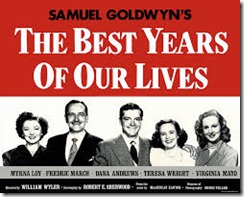Occasionally Phronesis will offer film commentaries. Though we are not film critics, sometimes a film with a strong political message may inspire a commentary. Such is the case with the 1947 film, The Best Years of Our Lives. I’ve seen this film many times before, but only after watching it again recently did I come to fully appreciate what a great and enduring film it is. This isn’t just my opinion, as the film won seven Academy Awards, including best picture, and earned as astonishing, for the time, $11 million.
Best Years tells the story of three soldiers returning to the same town from World War II: Captain Fred Derry (played by Dana Andrews), an Army Air Force bombardier, Army sergeant Al Stephenson (played by Fredric March), and Homer Parish (played by Harold Russell), who was in the navy. Each is gripped with fear and uncertainties about returning to “normalcy.” Fred returns to a beautiful wife (Virginia Mayo) who has been working in clubs while he was away, Al to a loving wife and family and position in a bank, and Homer to his family and fiancé. Each, however, has been scarred by the war. Fred has recurring nightmares about his bombing missions. Al has taken to drinking, and Homer has lost his hands in an explosion on ship and now has two hooks for hands. Their chance meeting after the war turns into a close friendship and a sharing of their respective post-war difficulties.
The film centers on the struggles of Fred, Al and Homer trying to readjust to civilian life. Fred has difficulty finding work because his skills, “killing Japs,” are not relevant to a new workplace environment that now places a premium on education, training, specialized skills, and experience. He can’t please his party-animal wife, whom he finds has developed a taste for the good life, and, other men.
Al returns to his family and job at the bank, but he is uneasy re-connecting emotionally with his faithful wife (Myrna Loy), and his son, who doesn’t seem to appreciate the war relics he brought home and pesters him with questions about Hiroshima and atomic energy, which his high school teacher had told him needs to be controlled, “or else.” At the bank, Al discovers it has adopted a policy of requiring collateral before granting loans, something most of his fellow returning soldiers lack. He is pressured to deny loans to veterans whom he believes are of strong character and can be trusted to repay.
Homer’s fiancé and parents are uneasy with his disfigurement, though they try hard not to show it. All three are returning to an America they find cold, unwelcoming, and less optimistic about the future. They all feel like misfits, unneeded relics of the past, a point that was powerfully illustrated in a scene near the end of the movie when Fred is strolling through a junkyard of dismantled B-17s, the planes he flew during the war. Like Fred, they had served their purpose, but were now unfit for the new era.
Al returns to his family and job at the bank, but he is uneasy re-connecting emotionally with his faithful wife (Myrna Loy), and his son, who doesn’t seem to appreciate the war relics he brought home and pesters him with questions about Hiroshima and atomic energy, which his high school teacher had told him needs to be controlled, “or else.” At the bank, Al discovers it has adopted a policy of requiring collateral before granting loans, something most of his fellow returning soldiers lack. He is pressured to deny loans to veterans whom he believes are of strong character and can be trusted to repay.
Homer’s fiancé and parents are uneasy with his disfigurement, though they try hard not to show it. All three are returning to an America they find cold, unwelcoming, and less optimistic about the future. They all feel like misfits, unneeded relics of the past, a point that was powerfully illustrated in a scene near the end of the movie when Fred is strolling through a junkyard of dismantled B-17s, the planes he flew during the war. Like Fred, they had served their purpose, but were now unfit for the new era.

